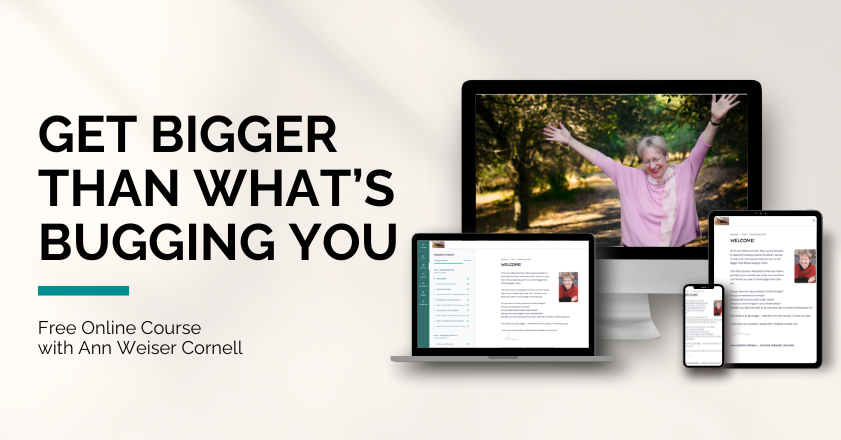Safe Focusing with (Almost) Any Partner
By Ann Weiser Cornell, PhD
This article originally appeared in the July 1992 issue of The Focusing Connection.
It always seems like a minor miracle: that I can sit in a class of beginners, with a new person listening to me for the first time, and have a fantastic Focusing session. And often in only ten minutes! Isn’t this remarkable? If I tried to convince someone from another tradition that I do some of my best Focusing in front of a group of relative strangers, accompanied by a brand-new listener, in such a short time, they might check me in somewhere for a long rest. But it’s true!
So if I try to explain the process that lets me feel safe enough to have a great session with a new listener, then this might help us understand how to feel safe as a focuser with almost any partner. First, we have an agreement that only listening responses will be given; no guiding. This means that I am in charge of guiding my own process. I know that I have a nice open space in front of me, without interference from the other person. I can take the time I need to find something, and not have to worry about being interrupted; as long as I am silent, the listener will be silent, too.
I know that the listener is just going to follow where I am, not try to interpret, analyze, anticipate, tie together, or even worry very much about understanding. The simplicity of our task together brings me a great inner peace. I am just going to be with myself, and the listener is just going to be with me.
Second, we have an agreement that my turn is mine and “The focuser is the boss.” This reminds me that it is not up to me as the focuser to take care of the listener. I don’t have to be interesting or productive for their sake. I can be silent the whole time and that would be OK. Or I can talk a mile a minute (I probably wouldn’t, but I could) and it would be up to the listener to figure out a way to keep up. That is our deal.
Third, I know it is my job to check what the listener says with my inside place, and to either speak up or ignore it if it’s not right. That way, it’s really the inside place that is guiding the session, and it won’t let anything happen that isn’t safe for me. Sometimes (very rarely) I have to say, “Please stay closer to what I’m saying,” or “I feel like you’re making a suggestion and I’d just like you to say what I said.” So even if the listener forgets our first agreements, this agreement keeps me safe.
Fourth, we have arranged a hand signal so I can stop the listener without even having to speak, if they begin to talk while something important is coming in me. It is part of our agreement that this is not something they need to feel defensive about, but a natural possibility in any session, that something may come in the focuser that needs silence from the listener now, and that’s OK.
The result of all these agreements is that I start the session by carefully taking time to be with myself inwardly and inviting “something” to come that wants to be known. When I first feel it, it’s usually very faint and hard to describe, so I describe it in a very approximate way. When the listener says back those words, I use them to pay closer attention to the sense. Better words come, and once again I hear them back and check them inside. Each response from the listener takes me deeper and deeper into my process.
By the end of the session, when we give feedback to each other, I often have to say that in a positive sense I hardly noticed the listener. By following the agreements and really being a mirror for me, they became transparent: still present as a person, but not at all clouding the vision.
But there is a dimension of feeling safe with a listener that doesn’t usually arise with a new person in a class. What happens if I know this person well enough to have some feelings about them, positive or negative, that might interfere with my experiencing them as a good clear mirror? Then, the session must start with some clearing of that. I would ask my inside place how much of what I am feeling is safe and right to say right now. Then I would say it, and the other person would reflect as a listener, and then notice in turn if there’s something they need or want to say to me.
(There is more that could be said about this whole territory of interpersonal space between the focuser and listener, and I hope that someone will address it, especially Barbara McGavin and Rob Foxcroft, whose illuminating conversation inspired me to write this much.) In most cases, this interpersonal clearing at the beginning of a session would take only a few minutes, and then I ask my inside place if it feels safe to continue. When I let it guide me, and my listener is being guided by it as well, the session almost always feels both safe and productive to us all.
This article appears in The Radical Acceptance of Everything, by Ann Weiser Cornell, PhD and featuring Barbara McGavin (Calluna Press; 2005). Learn more about this book.

